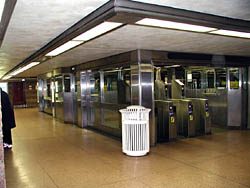
|
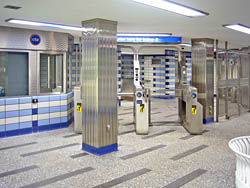
|
|
Left: The
Adams-Jackson mezzanine, looking southeast on December 10,
2001. The station mezzanine was remodeled in 1991, with
granite wall treatments, stainless steel paneling, and
rearranged fare controls. For a larger view, click
here.
(Photo by Graham
Garfield)
Right: The
Jackson-Van Buren mezzanine, looking northeast on April 30,
2007, the morning it reopened after renovation. The
aesthetics of the mezzanine, with the gray granite flooring
and multi-hue blue tiled walls, represent a new CDOT
renovation scheme for the Dearborn Subway. For a larger
view, click here.
(Photo by Graham
Garfield)
|
|
Jackson
|
|
(230S/36W)
Adams-Jackson
|
|
|
|
(312S/36W)
Jackson-Van
Buren
|
Jackson Blvd. and Dearborn Street,
Loop
Service
Notes:

|
Blue Line:
Milwaukee-Dearborn Subway
|

|
Accessible
Station
(Adams-Jackson
mezzanine)
|

|
Transfer
Station
(Transfer to Loop Elevated by farecard only; transfers to
Red Line subway unrestricted)
|

|
Owl
Service
|
Quick Facts:
|
Address:
|
230 S. Dearborn Street
(Adams-Jackson
mezzanine)
|
|
312 S. Dearborn Street
(Jackson-Van
Buren mezzanine)
|
Established: February 25, 1951
Original Line: Milwaukee-Dearborn Subway
Previous Names: none
|
Skip-Stop Type:
|

|
Station
|
Rebuilt: 1989-91
(Adams-Jackson mezzanine),
2005-07 (Jackson-Van
Buren mezzanine, platform)
Status: In Use
History:
Jackson/Dearborn is typical of the downtown Dearborn
and State Street
subway stations, consisting of two mezzanine entrances feeding each
end of the stop, which is a designated portion of a long "continuous"
platform that stretches the length of the Loop. The Dearborn
Subway's continuous platform, a bit shorter than its
record-setting State Street cousin, is 2,500 feet long. Jackson, as a
transfer station, also had two passageways to the State
Street Subway one block east. One was at the mezzanine level
between the Adams-Jackson mezzanines of each subway, while the other
was in the paid area and ran between the platforms below Jackson
Boulevard.
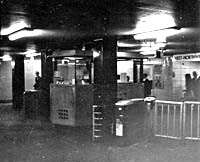
The Adams-Jackson mezzanine
appears as built in this July 19, 1971 view looking
southeast. Note that the marble-faced columns and structural
glass walls are the same as used in the State Street Subway,
rather than the glazed tile used elsewhere in the Dearborn
Subway. For a larger view, click here.
(CTA Photo)
|
The architecture of the station was streamlined Art Moderne with
some Art Deco elements, simple and austere compared to earlier
subways in New York, London, Paris or other systems but very much in
the style and fashion of the period in which it was designed. At
street-level, the entrances were very simple, consisting of stairs
down from the sidewalk surrounded by simple tubular railings with a
smooth identification pylon at the back with Deco rings around the
top. The fare controls were at a lower mezzanine level beneath
Dearborn Street. The station mezzanines had broadly curving walls,
which served to both reinforce the Moderne, streamlined architectural
style employed in the Initial System of Subways station as well as to
direct passenger flow through subtle design cues. The interior had
smooth concrete floors and ceilings, red for the former and a neutral
color for the latter. The fare control booths had an angled Deco
design and were made of stone walls with a small ventilation grate
near the bottom and glass windows on all four sides, allowing for
maximum visibility of the mezzanine for the station agents.
Turnstiles were steel, with some angled toward the entrances and a
number of self-serve coin-operated models for efficient traffic
circulation. Each mezzanine also had several amenities for the use of
passengers, such as public phones, lockers, restrooms, and
concessions.
The mezzanines at Adams-Jackson and at Jackson-Van Buren are
largely the same except for two differences. First, the mezzanines
had different wall finishes as originally built. This is a result of
the Adams-Jackson mezzanine opening concurrently with the State
Street Subway, eight years before the Jackson-Van Buren mezzanine
and the operation of the Dearborn
Subway (see below for more on the gap between subway
openings). Although the subway line itself wasn't open, the
upper-level transfer tunnel and Adams-Jackson mezzanine opened
concurrently with the State
Street Subway -- as did the passageway and mezzanine at Randolph-Washington
-- to allow convenient passage from Dearborn Street to the State
Street station via a below-grade walkway. Although it was not
operationally necessary to do so (since it didn't need to function as
a fare control facility or allow access to the platform), the wall
surfaces of the Adams-Jackson mezzanine were finished when it opened,
so it featured the structural glass wall cladding and black
marble-faced structural columns that the State
Street stations opened at the same time did. By the time the rest
Dearborn
Subway was finished and service inaugurated, the Department of
Subways and Superhighways made some modest changes to the station
finishes. As such, the Jackson-Van Buren foresaked the easily-broken
structural glass walls and marble-faced columns of the State
Street Subway for off-white glazed ceramic tile. Secondly, the
Adams-Jackson mezzanine was symmetrical across both axes, with two
sets of stairs and escalators down from the mezzanine to the
platform, one on the north half of the mezzanine and one on the
south. The Jackson-Van Buren mezzanine, however, was the last
entrance on the continuous platform and thus only fed the platform
from one side, with a stair and escalator down from the north half of
the mezzanine.
The island platform had red no-slip concrete floors, curved,
barrel-vaulted concrete ceilings and a row of I-beam steel columns
along each platform edge. Unlike some of the more ornate subways in
other cities, the walls along side the tracks in the stations were
left as unfinished concrete rather than tiled. To aid in station
identification, each station had a color scheme that was used in the
accents like tile borders, platform column color, and signage
lettering and background. The colors blue, red, green, and brown were
rotated in sequence beginning up at Division
& Milwaukee. Jackson's accent color was green. A
specially-designed Futura typeface was used throughout the subway on
metal, tile, and backlit glass signs. Fluorescent lights and
illuminated station signs hanging from the ceilings finished the
decoration.
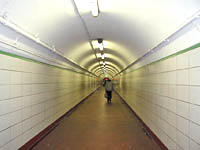
The Jackson transfer tunnel,
looking west on June 13, 2002, was simple in its original
Art Moderne form. The smooth, unadorned walls and curved
ceiling were typical features of the Depression-era
architectural style. For a larger view, click
here.
(Photo by Graham
Garfield)
|
The low-level transfer tunnel, which was built in 1939-1943 as part
of the original construction of the subways but not opened until the
Dearborn tubes
were put into service, was simple in design and execution, befitting
the streamlined architecture of the Depression-era subways. The floor
was smooth red concrete, the same as the station platform. The
ceiling of the majority of the tunnel was smooth arched concrete,
while the walls were large, smooth glazed tiles with a light green
trim along the top (consistent with Jackson being a "green" station
in the subway's scheme of four rotating highlight colors). At each
end, where the stairs to the subway platforms were, the ceiling
dropped down and became flat due to presence of the trackbed above
it. The wall tiles also changed from the large
horizontally-rectangular tiles to small vertically-rectangular ones.
There were two stairs to each island platform at each end of the
transfer tunnel. In the middle of the tunnel, both walls had
lettering inlaid in the tile, in the Futura typeface used throughout
the original subways, directing passengers which direction State
and Dearborn
streets were.
Though much of the structural work of the Dearborn
Subway was concurrent with that of State
Street's (which was begun in 1938 and opened in 1943),
construction on the Dearborn
line was suspended in 1941 due to wartime materials shortages. Even
after the war was over, it was another several years before work was
resumed. Finally, the Milwaukee-Dearborn
Subway was completed and opened on February 25, 1951, eight years
after the State
Street tubes were inaugurated. This is when Jackson station
opened.
Operational Changes
Upon the opening of the Congress
Line and the inauguration of West-Northwest
Route through-service in 1958, the locations of Loop-Subway
transfers downtown was changed. The old Dearborn/Van
Buren station, later an auxiliary entrance to State/Van
Buren, was right above the Jackson-Van Buren subway entrance, so
on June 22, 1958 a "down" transfer from the Loop
Elevated at State was
instituted to that Jackson mezzanine. Passengers could not transfer
"up" from the subway to the Loop here, however. This transfer
remained between Lake Transfer and
Clark/Lake at the north end of
downtown (or, if they really wanted to transfer in the South Loop,
they could transfer via the lower tunnel to Jackson/State,
where both "up" and "down" transfers to State/Van
Buren were allowed). This transfer policy remained in force until
September 28, 1969, when the Dan
Ryan Line and the West-South
Route service began. At this time, transfers in both directions
returned to Lake Transfer and
Clark/Lake, where they remain
today.
In the early 1960s construction began on the Chicago Federal
Center, a collection of government buildings above the Adams-Jackson
mezzanine. The high-level transfer passageway between the State
and Dearborn
subways temporarily closed on September 9, 1961 due to the
construction of the Dirksen Federal Building, reopening on October
15, 1961. The 30-story Dirksen courthouse building, designed by noted
architect Ludwig Mies van der Rohe, was completed in 1964. Eleven
years later, the 42-story Kluczynski Federal Building was built
across Dearborn Street. Completed in 1973, this project created a
large plaza on the corner of Adams and Dearborn (containing Alexander
Calder's famous red Flamingo stabile) resulting in the mezzanine
entrances from the west side of the street being reconfigured. The
northwest stairs to Adams-Jackson were closed, while the southwest
stairs were widened and modernized with new flooring, new wall
cladding, and a new street-level entrance. The mezzanine remained
unmodified, however, with the exception of the sealed stairway.
Amid a series of station closures and service reductions in the
1970s, the Jackson-Van Buren mezzanine entrance to the station was
reclassified as a part-time entrance, closed from 2200 to 0600 hours
Monday-Saturday and all day Sundays effective September 12, 1976.
This situation continued for nearly 25 years, with the exception of a
two-year period when the other mezzanine was being renovated (see
below). This operating plan was reversed at a press conference on
Monday, June 5, 2000, when CTA President Frank Kruesi announced that beginning Saturday, June 10th
and Sunday, June 11th, six downtown area "L" and subway stations and
seven station entrances that were closed late at night or on weekends
would be open at all hours that trains are in service. One of the
seven secondary part-time entrances to be reopened was Jackson-Van
Buren. Starting at 0600 hours Saturday, June 10th, Jackson-Van Buren
entrance returned to 24-hour operation. Opening these stations and
entrances is just one of the components of a $539,000 service
improvement package that was passed by the Chicago Transit Board in
May 2000.
Jackson Renovations
Plans have long been afoot to renovate Jackson station, though
they were implemented in piecemeal fashion. On Friday, May 7, 1982,
Mayor Jane Byrne announced the Subway Renovation Program.
Encompassing both the State
and Dearborn
subways, the renovation program included the continuous platforms on
State between Lake and Congress and on Dearborn between Randolph and
Van Buren; the 14 mezzanines along these platforms; and the four
pedestrian passageways connecting the State
and Dearborn
subways here and at Washington at both the mezzanines and platforms.
In addition, mezzanines and platforms would have been renovated at
Chicago, Grand,
Harrison, and Roosevelt
on State and the
Lake Transfer and LaSalle/Congress
stations on Dearborn.

An artist's conception of
the renovated Jackson/Dearborn platform shows a style
similar to what was built at Jackson/State, only more
simplified The basic 1940s structure will remain, with new
tunnel wall cladding, signage, flooring, and ceiling tiles
in the center vault. For a larger view, click
here.
(Image from Muller
& Muller
Architects)
|
At all mezzanines, the existing facilities were to be stripped back
to their basic structural shell and completely renovated with gray
granite panels with stainless steel accents. New fare collection
facilities, lighting, flooring, and column coverings were also to be
installed. A uniform system of signage and maps would be provided and
facilities for the enhancement of passenger security would be
incorporated. Amenities such as telephones and concession areas would
also have been provided as appropriate. At the platform level, new
lighting, flooring, wall, ceiling, and column treatments would have
been provided. Stairways and escalators from the platforms to the
mezzanines would be replaced or renovated in kind. Signage, maps,
benches, and concession facilities will be compatible with those
developed for the mezzanine.
Renovation was undertaken in 1982-83 at the two Washington
subway stations, but work at the other stations proceeded at a
delayed rate or, in some cases, not at all. Renovation and remodeling
of Adams-Jackson did not begin until 1989. This mezzanine, as well as
the Adams-Jackson mezzanine on the
State Street
Subway, closed on on March 11, 1989 to allow the $6.9 million
renovation project to began. At the same time, the Jackson-Van Buren
mezzanine temporarily returned to 24 hour service for the duration of
the renovation work.
Although completed nearly 10 years after the announcement of
Byrne's program, the renovation followed the same general
architectural plan first generated a decade before, with gradual work
on the design completed during the seven years between announcement
and commencement. The renovated Adams-Jackson mezzanine is markedly
different from its former self in both style and layout. Gone was the
mezzanine's Art Moderne style, trading it for '80s-style modern
finishes. Also gone was the mezzanine's bi-axial symmetry
(technically lost in '64 when the northwest stair closed), with the
new fare controls only on the south half of the station and the north
stair to the platform becoming exit-only with a mezzanine-level
rotogate. (The refurbished mezzanine is still largely symmetrical
across the north-south axis.) The renovated mezzanine has terrazzo
floors and granite-clad walls, with stainless steel accents, soffits,
agent's booths, and fare controls. Abandoning the angled booth and
fare controls of the old mezzanine, the new arrangement is strictly
rectilinear. There are two two-position agent's booths, one on the
west side of the mezzanine and one centered on the north end. Besides
the agent-controlled Visifare turnstiles on those sides, the east
side had coin-operated turnstiles facing the transfer tunnel. The
unpaid area was reduced to a corridor that followed the west, north,
and east walls of the mezzanine. Concession spaces were featured on
both sides of the unpaid area behind the stairs to the street. The
southeast stair was modernized similarly to the southwest one, but
not widened, while the northeast stair was removed (reducing the
street-to-mezzanine access from the as-built four stairs down to two)
in favor of an elevator. Meanwhile, the paid area of the mezzanine
was expanded southward behind the stairs and escalator to accommodate
the elevator to the platform, completing the station's accessibility.
Neither the platform (except for the elevator and new wall cladding
around the stairs to Adams-Jackson) nor the Jackson-Van Buren
mezzanine were modified in this renovation. The Adams-Jackson
mezzanines on both the State
and Dearborn
subways reopened on May 13, 1991. On the same date, the Jackson-Van
Buren mezzanine returned to part-time hours until 2000.
The other stations scheduled to be renovated under this program,
in this very modern style, were never undertaken, although five years
later Chicago Department of Transportation (CDOT) would begin another
subway renovation program. None of the platform-level remodeling was
ever completed under the Byrne or Washington administrations'
program.
The City did not revisit the idea of completing the Jackson
renovation for nearly a decade until, in the late 1990s, it was again
in CDOT's capital program. The Chicago Department of Transportation's
2002-05 Capital Improvement Program had the engineering and
design for the renovation of Jackson/Dearborn. Although CDOT no
longer uses the steely 1980's idea of modernity in its subway
designs, the project leaves Adams-Jackson as it is but follows a
different design aesthetic for the renovated platform and Jackson-Van
Buren mezzanine.
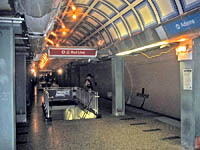
Renovation of the Jackson
platform is progressing in this September 3, 2006 view
looking north. Most of the new granite flooring has been
installed, as have the new ceiling vault tiles. Installation
of the new light trays is continuing, but for the time being
the platform was primarily lit by temporary construction
lighting. For a larger view, click here.
(Photo by Graham
Garfield)
|
Muller &
Muller Architects was responsible for architectural design
services for the renovation of the Jackson-Van Buren mezzanine and
Jackson portion of the continuous island platform. The firm was
tasked with reviewing the station entrances, mezzanines and platforms
and with making recommendations on a unified architectural treatment
for the downtown stations along the Blue
Line.
Work at Jackson-Van Buren and the Jackson platform included new
tile wall and granite floor surfaces, tile ceiling finishes and new
stainless steel light trays on the platform, new acoustical panels on
the tunnel walls, new escalators (including one from the street to
the mezzanine, a Dearborn
Subway first, not counting those in the Thompson Center and 203
N. LaSalle buildings at Clark/Lake) and
stairway finishes, new concession areas, a new Customer Assistant
kiosk, additional turnstiles, new street-level entrance kiosks, new
signage, new, brighter, energy-efficient lighting, new security
cameras and monitoring equipment, revisions to platform ETS systems,
and maintenance needs.
Test designs for a new tile pattern for the arched ceiling over
the continuous platform were tested north of the Adams-Jackson
mezzanine, on the unused section of the continuous platform between
the Jackson and Monroe stops, with
paper mockups in Autumn 2001. The paper patterns were left on the
ceiling long after evaluation was complete and were not removed until
2005.
The construction phase of the renovation program for Jackson-Van
Buren and the Jackson platform began on Friday, November 4, 2005. At
9pm that day, the Jackson-Van Buren mezzanine closed temporarily for
the weekend while much of the mezzanine was partitioned off to allow
construction to begin. The mezzanine reopened on Monday, November 7,
2005 at 5am as an exit-only facility. Similar to an arrangement that
was used at Lake station during its
renovation in 2004-05, closing off most of the mezzanine from public
access allowed the construction contractor nearly unrestricted access
to work quickly and efficiently while still at least allowing
customers to use the mezzanine as an exit if not an entrance. The
northwest, southwest and southeast stairs were temporarily closed.
The northeast stairs remained open for egress with a rotogate
controlling access in the mezzanine. The Adams-Jackson mezzanine
remained open, 24-hours a day, during the project.
Once the Jackson-Van Buren mezzanine was largely closed to
passengers traffic (except for the exit passage), general contractor
FHP Tectonics
and their subcontractors set to work demolishing the mezzanine and
removing the existing concrete flooring on the platform for
replacement. The south stairs from the platform to the lower-level
transfer tunnel to the State
Street Subway were closed for renovation; the north stairs
remained open. During late 2005 and early 2006, the contractors
stripped the Jackson-Van Buren mezzanine back to its structural shell
and began installing few electrical, mechanical, and communications
infrastructure. In March 2006, the egress from the Jackson-Van Buren
mezzanine to the street was moved from the northeast stair to the
street to the southwest stair.
By the end of March 2006, metal liner panels were installed along
most of the center vault over the platform. Work had also been
initiated on installing new granite flooring and stripping the
existing I-beam columns of decades of paint. By mid-May 2006, the
renovation of the south stairs to lower-level transfer tunnel was
completed and the stairs were reopened, and the north stairs were
closed for improvement. The new granite platform flooring was
installed from the south transfer tunnel stairs to the stairs to the
Jackson-Van Buren mezzanine and installation of the new ceiling tile
panels in the central vault had begun at the south end of the
platform. Granite for the floors was brought to the station for the
flooring subcontractor, W.
R. Weis Company, by a series of chartered work trains.
Work continued apace into Summer 2006, when work in the
Jackson-Van Buren mezzanine concentrated on installing new
electrical, communications, and HVAC systems, as well as the
beginning to install the new wall and floor cladding. The walls are
tiled in a pattern of blue, gray, and white hues, while the red
concrete floor is being replaced with light gray granite tiles. The
columns and other accents were sheathed on stainless steel, decorated
with a Deco-style zig-zag pattern etched in the steel. Work required
the mezzanine to be closed over the weekend of August 4-6, 2006, and
upon reopening at 5am on Monday, August 7 the northwest
mezzanine-to-street stair -- where egress to the street had since
been moved to -- was closed. Exiting was again from the northeast
stair.
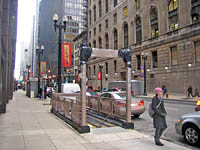
One of the two new
street-level entrance kiosks -- at the southwest quadrant --
is seen looking north on November 30, 2006. This one was
open as an exit-only, while the northwest one also installed
in November 2006 is seen in the background surrounded by a
plywood enclosure. The design of the kiosk is the same as
CDOT used at Chicago/State in 2001. For a larger view, click
here.
(Photo by Graham
Garfield)
|
Progress also continued on the Jackson platform. By September 2006,
the new platform flooring had been completed, consisting of light
gray granite with dark gray granite panels under the colonnade along
the platform edges. The west end of the lower-level transfer tunnel
was completed, as were both stairs from the tunnel to the platform
and the associated railings and grillework.
Installation of the new tile panels down the center vault of the
platform were also completed during Summer 2006 and most of the new
stainless steel light trays along the colonnade soffit were also
installed. The light trays, installed by subcontractor MG Electric,
consist not only of down-lights and up-lights that put illumination
on the platform and ceiling vaults, respectively, but also backlit
signs that direct passengers to the mezzanine exits, provide the
station name, transfer information and directional line maps, and
include integrated LED signs.
By the end of November 2006, the wall tiling in the Jackson-Van
Buren mezzanine appeared to be largely complete, with some fittings
such as backlit advertising panels already installed. Some work was
still taking place behind the plywood walls that channel passengers
from the platform stairs to the street. During autumn, the new
escalator from platform to mezzanine level was installed, with the
subcontractor, KONE,
delivering the new escalator to the platform using a chartered work
train from.
At street level, the first two new entrance kiosks were installed
by the end of November 2006, both on the west side of Dearborn Street
next to the historic Monadnock Building. The stair enclosures are
copies of the one installed on the northwest corner at Chicago/State
in 2001, with two globe-topped posts in front with an entrance sign
between them, a decorative railing around the sides and back, and a
small peaked roof over the stairs at the rear of the stair opening.
The southwest entrance was in use (as an exit), while the northwest
stairs were still enclosed by a plywood enclosure. When originally
installed, the stair kiosks were gold-colored.
At platform level, all of the new gray granite flooring, ceiling
tiling, and light trays with associated backlit signage was in place
by the end of 2006 and the I-beam columns down the platform were
painted light gray. The tunnel walls had been painted white, except
for the bottom few feet, which were painted dark gray (probably to
obscure the omnipresent brake dust that settles on the bottom of the
tunnel walls). On the southbound side, the brackets had been
installed on the tunnel wall for the new acoustical paneling.
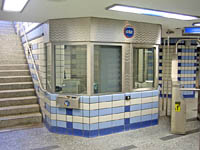
The Customer Assistant's
booth was moved from the middle of the mezzanine to the
northwest corner in the renovation, integrated into the wall
wit glass windows on three sides. Note the cast CTA logo and
Deco zig-zag pattern on the cap, looking north on April 30,
2007. For a larger view, click here.
(Photo by Graham
Garfield)
|
In mid-January 2007, the third entrance kiosk, identical to the
other two previously installed on the west side of Dearborn Street,
was installed on the east side of Dearborn for the northeast stair
from the mezzanine. The kiosk was surrounded by a plywood enclosure,
as the stairway was still closed to traffic. By mid-February 2007,
all of the acoustical panels were installed on the tunnel walls
opposite the platform, except for the top row where the station name
signs and a colored band (blue, in this case) would be affixed. A
bench, identical in design to those used at the renovated Jackson
and Lake Red
Line stations, was also installed at the south end of the
platform, sporting curved wood slat seats and stainless steel circles
that double as legs underneath, mounted on granite bases, and as a
curved bar projecting through the slats at each end of the bench.
At the end of February 2007, the entrance kiosk for the new
mezzanine-to-street escalator, in the location formerly occupied by
the southeast stairway, was installed. The kiosk is similar to those
used by CDOT at Chicago/State in
2001, except it is narrower (those at Chicago
house a stair and an escalator; this one only houses an escalator)
and it is black rather than gold. The kiosk was enclosed in plywood
as it was not in use, although the top of the tall kiosk poked up out
of its plywood container.
During late April 2007, a flurry of activity was performed to
ready the Jackson-Van Buren mezzanine for reopening. During this
period, the top row of acoustical panels on the tunnel wall opposite
the platform were installed, featuring station name signs and a
reflective blue band. At 9pm, Wednesday, April 25, the mezzanine
closed completely to allow the final preparatory work to be
performed. During this final week, additional fixtures were
installed, including the flat panel information screens in the south
mezzanine wall and in the freestanding Transit Information kiosk on
the platform between the stairs to the lower transfer tunnel.
Additional signage was installed, as were more backlit graphics in
the platform light tray, although the installation of both would
continue into May. Beginning Friday, April 27 and into the weekend,
the mezzanine and platform were thoroughly cleaned and polished and
the stair entrance kiosks on Dearborn Street were painted black. Over
the weekend, the turnstiles and farecard vending machines were
installed in the mezzanine.
At 5am, Monday, April 30, 2007, the Jackson-Van Buren mezzanine
reopened for entering traffic and the full length of the platform was
available for use. Additional punchlist work continued during the
following weeks.
The cost of the renovation project was estimated at $9
million.
Other Developments
Besides renovating the entire south mezzanine and platform, the
CTA is also assuring that
other aspects of the station are kept in working order. Continuing to
upgrade and replace some of the oldest escalators in the
CTA system, the Chicago
Transit Board approved a $642,569 design contract for the replacement
of 10 Loop subway escalators on June 4, 2003. The design work is the
precursor to replacing the units with new escalators. The escalators
pegged for replacement include seven on the Red
Line and three on the Blue
Line, including one at Jackson-Van Buren. Chicago-based Globetrotters
Engineering Corporation was selected to provide architectural and
engineering services for the project following a competitive bidding
process. Rehabilitation involves completely stripping an escalator of
all parts and replacing it with new or reconditioned parts, keeping
only the original outer shell. Decisions on which escalators receive
rehab or replacement are based on the age of the escalator, the
condition of the escalator and the volume of customers passing
through the station. The Regional
Transportation Authority and the Federal
Transit Administration are providing capital funding for the
contract. Construction took place between September 2004 and May
2006.
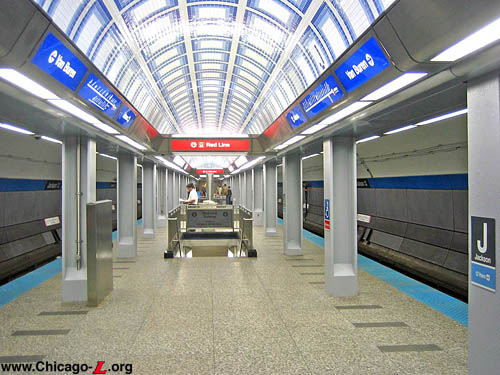
The renovated Jackson
platform is seen looking north on April 30, 2007. The
2006-07 rehabilitation brought the gray granite flooring,
tiled ceiling, light trays with backlit signs and
directional maps, and gray acoustical panels on the tunnel
walls. For a larger view, click here.
(Photo by Graham
Garfield)
|
 Original Jackson
station (1951-2006) |
Renovated Jackson
station (2006-present)
Original Jackson
station (1951-2006) |
Renovated Jackson
station (2006-present)
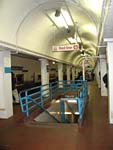
|
jackson01.jpg
(138k)
The south stairs from the Jackson platform down
to the low-level transfer tunnel, looking north on June 13,
2002, one day before its closure for rehabilitation. The
simple, tubular railings that angle out at the opening are
much simpler in design than their Deco counterparts in the
State Street
Subway, but convey streamlined, "futuristic" feel
typical of its early 1950s construction.
(Photo by Graham Garfield)
|
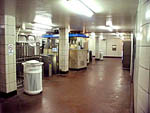
|
jackson-vanburen01.jpg
(138k)
The Jackson-Van Buren mezzanine, looking east on June
16, 2001 still in its as-built configuration. Its design and
aesthetics are typical of the Milwaukee-Dearborn
Subway stations. (Photo by Graham
Garfield)
|
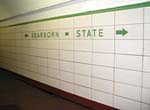
|
JacksonTunnel02.jpg
(92k)
At the midpoint between the subways in the
tunnel, the walls had lettering inlaid in the wall tile to
instruct transferring riders which way each subway was. The
Futura-like lettering was standard for the original subways.
This view if of the north wall on June 13, 2002.
(Photo by Graham Garfield)
|
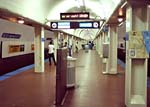
|
jackson03.jpg
(141k)
The Jackson stop in the Dearborn
Subway is seen looking north on June 16, 2001 from the
bottom of the stairs to the Jackson-Van Buren mezzanine.
Except for the addition of new signage fluorescent lights,
and A/V readouts, plus a whitewash over the green columns
and bare concrete walls of its as-built design, the platform
had changed little in 50 years. (Photo by
Graham Garfield)
|

|
jackson-NBsign1.jpg
(65k)
When the first generation of KDR-type
symbol signs were installed at Jackson station, the
northbound sign gave a very general destination of the
"Northwest side". The terminal at the time was, in fact,
Jefferson Park.
(Sign from the Andrew Stiffler
Collection)
|

|
jackson-NBsign2.jpg
(60k)
After the West-Northwest
Route was extended from Jefferson
Park to O'Hare in 1984, the
destination on the northbound symbols signs were changed to
more specifically list the terminal station rather than just
the Northwest Side. Initially, many signs, like this one
from Jackson, simply had stickers put over the destination.
Later, many were remade with the corrected destination.
(Sign from the Andrew Stiffler
Collection)
|
Renovated Jackson
station
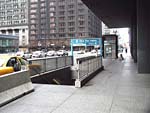
|
adams-jackson02.jpg
(198k)
The southeast stairs down to Adams-Jackson
mezzanine from the east side of Dearborn Street are seen
looking north on December 10, 2001. The rectilinear polished
metal entranceway is made to harmonize with the modern
Dirksen Federal Building next it, along with the rest of
Federal Center. The elevator to the mezzanine, added in 1991
on the site of the original northeast stairway for
accessibility, is seen in the background.
(Photo by Graham Garfield)
|
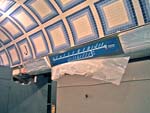
|
jackson05.jpg
(184k)
A directional line map -- for the southbound Blue
Line -- can be glimpsed in the newly-installed light
tray along the colonnade soffit on August 6, 2006. Following
their installation, CDOT has largely kept these maps covered
while construction continued. (Photo by Tony
Coppoletta)
|
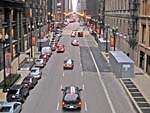
|
jackson-vanburen03.jpg
(205k)
The four entrances to the Jackson-Van Buren
mezzanine are seen from the Library
station elevated platform above on November 30, 2006. At
this point, the two stair kiosks on the west side of the
street (left) have been installed, with the south one of the
pair open for exiting, while those on the east side of the
street are yet to be installed. The closed stairs are
covered by plywood enclosures. (Photo by
Graham Garfield)
|
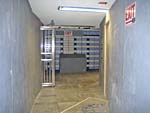
|
jackson-vanburen04.jpg
(148k)
The plywood-walled corridor built for exiting
passengers through the under-renovation Jackson-Van Buren
mezzanine is seen looking south on November 30, 2006. Behind
the walls, renovation works continues. Note the compass rose
inset in the granite floor and the blue, gray, and white
wall tiling seen in the background. (Photo
by Graham Garfield)
|
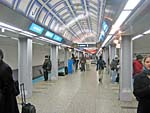
|
jackson06.jpg
(189k)
The renovation of the Jackson platform is far
along in this November 30, 2006 view looking south. By this
time, the new flooring, ceiling tiles, and light trays are
installed and in use. The columns have been painted a light
gray, and the tunnel walls have been painted white with the
gray band at the bottom, probably to obscure the omnipresent
brake dust that settles on the bottom of the subway tunnel
walls. Note the colored backlit signage in the new light
trays. (Photo by Graham Garfield)
|
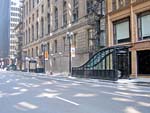
|
jackson-vanburen05.jpg
(186k)
The stair and escalator kiosks on the east side
of Dearborn Street are seen looking northeast on April 30,
2007. The kiosks have an Art Nouveau-inspired design and are
similar to those CDOT first used at Chicago/State
in 2001. The escalator kiosk, which provides exiting only,
is in the foreground, while a stairway kiosk is in the
background. (Photo by Graham
Garfield)
|

|
jackson-vanburen06.jpg
(213k)
One of the three stair entrance kiosks at
Jackson-Van Buren -- this one for the northeast stair to
mezzanine -- is seen looking southwest on April 30, 2007.
The entranceway is nearly identical to the one installed at
Chicago/State in 2001,
except it is black instead of gold, the lettering style on
the overhead sign is a bit different, and, o course, the
neon is blue instead of red. Note the cast
CTA logos inset into
the posts. (Photo by Graham
Garfield)
|

|
jackson-vanburen07.jpg
(178k)
The escalator kiosk at Jackson-Van Buren is seen
looking north on April 30, 2007. The kiosk's design is
similar to those used by CDOT at Chicago/State
in 2001, using the same Art Nouveau-inspired style, except
it is narrower -- those at Chicago
house a stair and an escalator, but Jackson's only houses an
escalator. Jackson-Van Buren has the first escalator from
the street to the mezzanine on the Dearborn
Subway, not counting those in the Thompson Center and
203 N. LaSalle buildings at Clark/Lake.
(Photo by Graham Garfield)
|
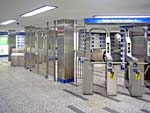
|
jackson-vanburen10.jpg
(178k)
The renovated Jackson-Van Buren mezzanine is seen
looking northwest on April 30, 2007. The turnstiles are
angled toward the southeast and southwest to channel
passengers to and from the access to and from the street. In
between, in the location formerly occupied by the agent's
booth, a gate was installed that can be opened for special
events where portable fareboxes might be used for additional
capacity, or for other uses. (Photo by
Graham Garfield)
|
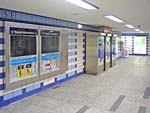
|
jackson-vanburen11.jpg
(170k)
The south wall of the renovated Jackson-Van Buren
mezzanine is seen looking southwest on April 30, 2007, with
its new multi-hue blue and white tile finishes. Note the
"SE" in the header course at the top left, subtly telling
passengers it's the southeast corner of the mezzanine. The
plasma screens are intended by CDOT to replace maps,
timetables, or other printed materials posted by
CTA at stations.
(Photo by Graham Garfield)
|
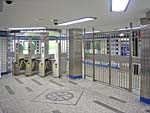
|
jackson-vanburen12.jpg
(180k)
The paid area of the renovated Jackson-Van Buren
mezzanine is seen looking southeast on April 30, 2007. Note
the compass rose inset in the new granite floor and the
Deco-inspired zig-zag decorative pattern etched in the new
stainless steel column sheathing and grilles. The mezzanine
and platform are outfitted with several security cameras as
well. (Photo by Graham Garfield)
|
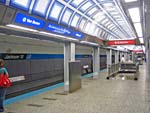
|
jackson07.jpg
(202k)
The renovated Jackson platform is seen looking
north on April 30, 2007, just south of the stairs down to
the lower-level transfer tunnel to the State
Street Subway. Note the increased illumination aided by
the tiled ceiling that help reflect the additional light,
and the direction-specific line map backlit in the light
tray. (Photo by Graham Garfield)
|
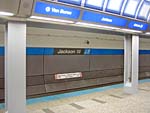
|
jackson09.jpg
(138k)
The view show the backlit signage in the new
light trays -- with the station name in the middle and exit
information flanking it -- which mimics
CTA -standard station
name signs, which have a station name sign in the middle and
colored tabs on the sides. The difference here is that CDOT
chose to make the station name part the line color instead
of the neutral gray the
CTA uses. In the
background, on the tunnel wall, is a standard
CTA station name
sign. This view looks northwest on April 30, 2007.
Advertising panels, artwork, and directional map signs have
yet to be installed on the acoustical panels at this point.
(Photo by Graham Garfield)
|
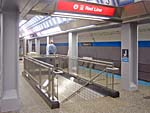
|
jackson10.jpg
(160k)
The new railings around the stairway from the
Jackson platform to the lower-level transfer tunnel to the
Red Line's
State Street
Subway is seen looking northeast on April 30, 2007. The
railing design is much simpler and more rectilinear than
those CDOT
installed at Jackson on
the Red Line in
2003. (Photo by Graham Garfield)
|
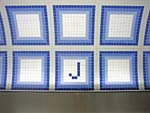
|
jackson11.jpg
(153k)
A detail of the new ceiling tilework on the
center vault over the platform is seen on April 30, 2007.
Like the stations CDOT renovated on the Red
Line, the tilework includes the first letter of the
station name. (Photo by Graham
Garfield)
|

- Jackson_Blue_next.wav
(114k): "Jackson is next. Doors open on the left at
Jackson." (Sound
courtesy of Tony Coppoletta)
































